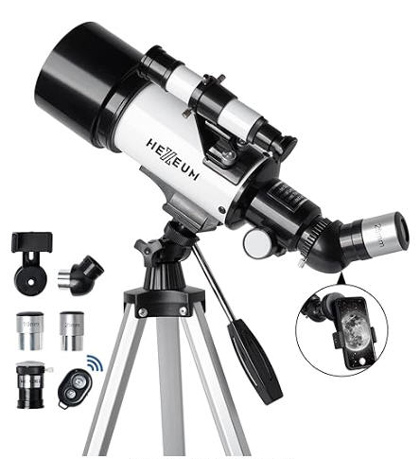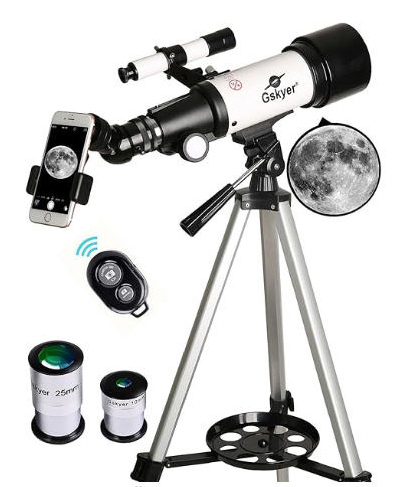Table of Contents
For children with a natural curiosity about the stars, planets, and the vast expanse of space, telescope toys offer a fantastic gateway to exploration and learning. More than just playthings, these miniature versions of sophisticated astronomical instruments can spark a lifelong interest in science, astronomy, and the wonders of the universe. Let’s embark on a detailed journey through the diverse landscape of telescope toys, exploring their benefits, types, features, and how to choose the perfect one for your budding astronomer.
Igniting the Spark: The Educational Power of Telescope Toys
While not designed for professional-level astronomical observation, telescope toys offer a multitude of educational and developmental benefits for children:
- Fostering Scientific Curiosity: Telescope toys introduce children to the fascinating world of astronomy, encouraging them to ask questions about the cosmos and seek answers through observation and learning.
- Introducing Basic Astronomical Concepts: They provide a tangible way to understand concepts like magnification, celestial objects (Moon, planets, stars), and the idea of observing things at a distance.
- Developing Observation Skills: Using a telescope toy requires patience and focus, helping children develop their observational skills and attention to detail.
- Enhancing Spatial Reasoning: Understanding how to aim and focus a telescope can improve a child’s spatial reasoning and understanding of angles and distances.
- Encouraging Imaginative Play: Telescope toys can fuel imaginative play scenarios, from pretending to be astronauts on a space mission to discovering new planets in distant galaxies.
- Promoting STEM Learning: By making science engaging and hands-on, telescope toys can contribute to a child’s interest and aptitude in STEM (Science, Technology, Engineering, and Mathematics) fields.
- Family Bonding: Observing the night sky together with a telescope toy can be a wonderful family activity, fostering shared experiences and discussions about the universe.

A Universe of Options: Exploring the Different Types of Telescope Toys
The market for telescope toys offers a wide array of designs, features, and price points. Understanding the different types can help you choose the most suitable option for your child’s age and interests:
1. Refractor Telescope Toys: Learning with Lenses
Similar in principle to real refracting telescopes, these toys use lenses to bend light and create a magnified image.
- Characteristics: Often feature a long, slender tube with a lens at the front (objective lens) and an eyepiece at the back. They tend to be relatively simple to use and can provide clear views of bright objects like the Moon.
- Considerations: Image quality can vary significantly depending on the quality of the lenses used. Some cheaper models may suffer from chromatic aberration (color fringing around objects).
2. Reflector Telescope Toys: Mirroring the Cosmos
These toys mimic the design of reflecting telescopes, using mirrors to gather and focus light.
- Characteristics: Typically feature a wider, shorter tube with a primary mirror at the back. They often offer larger apertures (light-gathering ability) for their price compared to refractors.
- Considerations: May require more initial setup and occasional alignment (collimation). Some designs might have a secondary mirror that slightly obstructs the light path.
3. Catadioptric Telescope Toys: Combining Lenses and Mirrors
Some more advanced telescope toys utilize a combination of lenses and mirrors, similar to Schmidt-Cassegrain or Maksutov-Cassegrain telescopes.
- Characteristics: Often more compact than refractors or reflectors of similar aperture. Can offer a good balance of image quality and portability.
- Considerations: Tend to be on the higher end of the price spectrum for telescope toys.
4. Tabletop Telescope Toys: Portable Exploration
These smaller, more compact telescopes are designed for easy setup on a table or flat surface.
- Characteristics: Often come with a simple mount and may be either refractor or reflector designs. Ideal for beginners and younger children due to their ease of use and portability.
- Considerations: May have smaller apertures and lower magnification capabilities compared to larger models.
5. Digital Telescope Toys: Merging Technology with Astronomy
Some modern telescope toys incorporate digital features, such as built-in cameras, screens, and software with information about celestial objects.
- Characteristics: Can provide a more interactive learning experience by displaying images and information directly. May offer the ability to take pictures or videos of observed objects.
- Considerations: Image quality may still be limited by the optics. The digital features can sometimes be more of a novelty than a significant improvement in viewing capability.

Key Features to Consider When Choosing a Telescope Toy
Selecting the right telescope toy for your child involves considering several factors:
- Age and Skill Level: Younger children will benefit from simpler, more robust models with easy-to-use controls. Older children with a deeper interest might appreciate more advanced features and higher magnification.
- Aperture (Objective Lens or Mirror Diameter): A larger aperture gathers more light, resulting in brighter and more detailed views, especially of fainter objects. Look for the aperture size in the product specifications (usually in millimeters).
- Focal Length: The focal length determines the magnification potential of the telescope when used with different eyepieces. A longer focal length generally yields higher magnification with the same eyepiece.
- Magnification: Often advertised prominently, magnification is determined by the telescope’s focal length divided by the eyepiece’s focal length. While higher magnification might seem appealing, it’s crucial to have sufficient aperture to produce a bright and clear image at high power. Start with lower magnifications for easier viewing.
- Eyepieces: Most telescope toys come with one or more eyepieces, each offering a different level of magnification. Look for toys that offer at least a couple of different magnification options.
- Mount: The mount is what supports the telescope and allows it to be pointed at different parts of the sky. Simpler alt-azimuth mounts (moving up/down and left/right) are common for beginner telescopes.
- Finder Scope: A small, low-magnification telescope attached to the main telescope that helps with aiming at specific objects. A useful feature for beginners.
- Build Quality and Durability: Children’s toys need to withstand some handling. Look for models made from sturdy materials.
- Ease of Use: The telescope should be relatively easy for a child to set up, aim, and focus. Complex controls can be frustrating for young learners.
- Safety: Ensure the materials used are non-toxic and that there are no small parts that could be a choking hazard for younger children.
- Educational Value: Consider if the toy comes with any educational materials, such as star charts or guides, to enhance the learning experience.
Tips for Making the Most of Telescope Toys
Once you’ve chosen the perfect telescope toy, here are some tips to encourage your child’s exploration of the night sky:
- Start with Easy Targets: Begin by observing bright and easily visible objects like the Moon. Its craters and mountains are fascinating to see even with a small telescope.
- Explore the Planets: Depending on the time of year and your location, bright planets like Venus, Mars, Jupiter (and its moons!), and Saturn (and its rings!) can be visible with even modest magnification.
- Find a Dark Location: Light pollution from city lights can significantly hinder viewing faint objects. If possible, venture to a darker location away from bright lights.
- Be Patient: Learning to find and focus on celestial objects takes practice. Encourage patience and persistence.
- Use Star Charts and Apps: Introduce your child to star charts or astronomy apps on a tablet or smartphone to help them identify constellations and celestial objects.
- Make it a Family Activity: Observing the night sky together can be a fun and educational experience for the whole family.
- Connect with Local Astronomy Clubs: Many communities have amateur astronomy clubs that host star parties and offer resources for beginners.
- Encourage Further Learning: Supplement telescope observations with books, documentaries, and online resources about astronomy.
Beyond the Toy: Nurturing a Lifelong Passion
While telescope toys may not reveal the faint galaxies or nebulae visible through research-grade instruments, they serve a crucial role in igniting a child’s curiosity about the universe. By providing a tangible and engaging way to explore the night sky, these toys can be the first step on a lifelong journey of scientific discovery and wonder. As your child’s interest grows, you can consider upgrading to more sophisticated amateur telescopes, opening up even more of the cosmos for exploration. The most important thing is to foster that initial spark of curiosity and encourage them to keep looking up!
